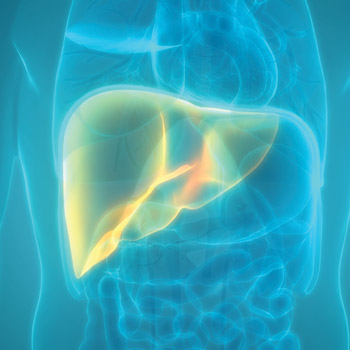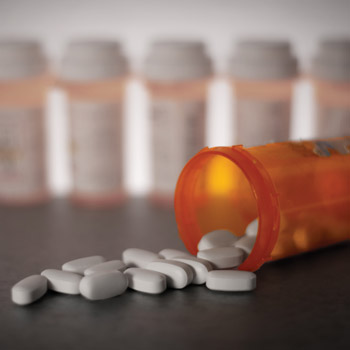How COVID-19 affects the liver
There is increasing evidence of direct, virally mediated liver injury caused by SARS-CoV-2, leading to enzyme elevations, lobular necroinflammation and/or portal interface hepatitis, and steatosis.
Liver enzyme elevations are common in patients with COVID-19, Elizabeth C. Verna, MD, MSc, said at the Liver Meeting Digital Experience's COVID-19 and the Liver Clinical Symposium, held last November by the American Association for the Study of Liver Diseases.
“Although they're often mild, they may limit our therapeutic options, and it is associated with disease severity and death,” she said. “There is increasing evidence of a component of direct, virally mediated liver injury in these patients, and certainly, we still have more work to do to understand the pathophysiology of this process.”

There have been reports of liver enzyme elevation as a common phenomenon since the very first published descriptions of the clinical manifestations of COVID-19 from China. Now, the literature on the association between COVID-19 and elevated liver tests is extensive, with several meta-analyses and systematic reviews supporting it, said Dr. Verna, a hepatologist at Columbia University Irving Medical Center in New York City.
“While the proportion of patients with evidence of liver injury varies by geographic location, the definition of the upper limit of normal, the disease severity in the cohort, and the timing of the liver enzyme measurement in the disease course, overall, elevation in liver tests [has] been reported in 14% to 53% of inpatients with COVID-19,” she said.
Across studies, aspartate aminotransferase (AST) is generally the most commonly elevated value. In one meta-analysis, largely of reports from China, the pooled prevalence of liver injury was 19% in 12 studies, according to results published in the July 2020 The Lancet Gastroenterology & Hepatology. The pooled prevalence of increased AST was 21%, followed by increased alanine aminotransferase (ALT) at 18%, increased total bilirubin at 6%, and decreased albumin at 6%.
In addition, Dr. Verna's group found that the overall initial and peak AST and ALT levels were elevated among 2,270 patients with confirmed COVID-19 compared to 1,108 controls who tested negative for SARS-CoV-2 but were hospitalized during the same period, according to results published online last May by Hepatology. “But these elevations were generally mild, with the peak ALT over the upper limit of normal in 45% [of patients with COVID-19] but over five times the upper limit of normal in only 6%,” she noted.
Liver enzyme elevation may not be initially present in patients with COVID-19 and may be a later manifestation of the disease, following progressive pulmonary and kidney manifestations, Dr. Verna said. “And each individual assay in the liver function panel may have a different trajectory, with ALT perhaps being the most reflective of the clinical association between the virus and liver injury,” she said.
However, researchers who have evaluated predictors of liver injury in many cohorts have found variable results overall. “In our cohort, there was not a clear association between liver enzyme elevation (defined by ALT over five times the upper limit of normal) and some of the traditional risk factors for severe COVID-19, including advanced age and elevated [body mass index],” Dr. Verna said. “Rather, there was a clear association with other inflammatory markers, including [interleukin-6] and ferritin, even [after] controlling for these traditional risk factors, perhaps implicating, at least in part, the host immune response in the pathogenesis of elevated ALT in this case.”
While liver enzyme elevation in patients with COVID-19 is generally mild and does not require a specific intervention, it may be an important prognostic marker, she said. For example, a meta-analysis published online last August by Annals of Hepatology showed a significant association between elevated AST and elevated ALT levels and critical illness related to COVID-19.
Dr. Verna added that in data from her center, “We did find that peak ALT was highly predictive of death or discharge to hospice [after] controlling for advanced age, comorbidities that have been associated with COVID-19, and … markers of critical illness, including the need for intubation or renal replacement therapy.”
The causes of liver enzyme elevation are likely multifactorial, she said. “Certainly, underlying liver disease may play a role in a certain portion of our patients. For those that require ICU-level care, sepsis, ischemia, and congestion are important considerations,” said Dr. Verna, adding that nonhepatic sources are also important to consider, particularly when AST is elevated out of proportion to other markers. Drug-induced liver injury may be quite common as well, and both the host immune response and direct virally mediated liver injury are also likely playing a role, she said.
In addition, ACE2, the receptor for the SARS-CoV-2 virus, is expressed in the liver itself, Dr. Verna said. “This has been shown in a number of different studies with different methodologies. … Probably cholangiocytes have the highest level of expression, but there is also documented expression in hepatocytes themselves,” she said.
There is also a growing literature on the histological changes in the liver that are seen in patients with COVID-19, predominantly from postmortem studies, Dr. Verna noted.
“These findings do include findings typical of a virally mediated process. In the first 40 autopsies reviewed at our center for patients that died of COVID-19, about half of patients had lobular necroinflammation and/or portal interface hepatitis,” she said. “In addition, we also found high rates of steatosis, as has been reported by other groups as well, with 75% of patients overall having steatosis (many without traditional risk factors for this) and about 30% with moderate or severe steatosis.”
Vascular findings included phlebosclerosis, endothelial injury, and sinusoidal thrombosis, as well as thrombotic bodies that are thought to be aggregations of platelets, Dr. Verna added.
Her research group also looked for SARS-CoV-2 in liver tissues using polymerase chain reaction (PCR) testing on 20 autopsy livers. Eleven (55%) liver specimens were positive for the virus, according to results published online last August by Modern Pathology.
“Interestingly, although the numbers are small, there was no correlation between a positive PCR in the liver tissue and the time from diagnosis to death or any of the individual lab test results, although those with a positive PCR had a trend towards higher AST and ALT [levels],” Dr. Verna said.
Patients with chronic liver disease may be at increased risk of severe COVID-19 outcomes, particularly those with nonalcoholic-associated fatty liver disease; however, the greatest impact may be among those with decompensated cirrhosis, she said. On the other hand, liver transplant recipients do not seem to be at higher risk of mortality from COVID-19 compared to the nontransplant population, said Dr. Verna.
For patients with COVID-19 and elevated serum liver biochemistries whose tests are stable or improving, the only necessary intervention is close monitoring, whereas those with worsening liver tests should be evaluated for other causes (e.g., myositis), she said.
“Luckily, as liver enzyme abnormalities are often mild and resolve on their own, minimal initial workup is currently recommended, including testing for viral hepatitis, such as hepatitis A, B, and C,” Dr. Verna said. “Additional workup, including imaging and other studies, is probably most likely reserved for patients with progressive or severe liver enzyme elevation or in patients with more of a cholestatic pattern, which would be less typical of COVID-19-related liver injury.”




